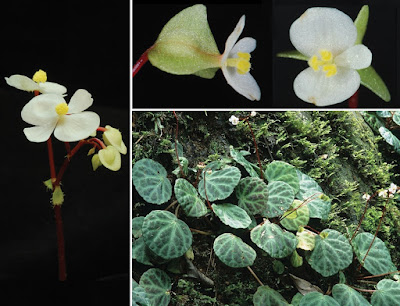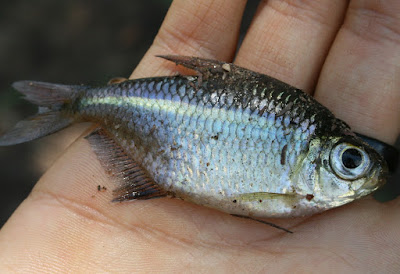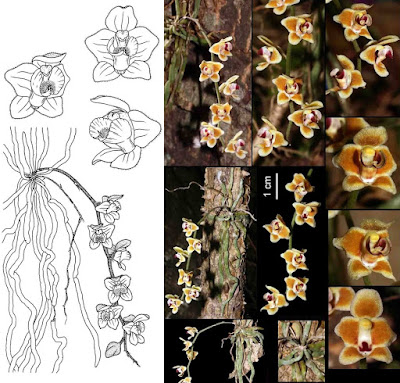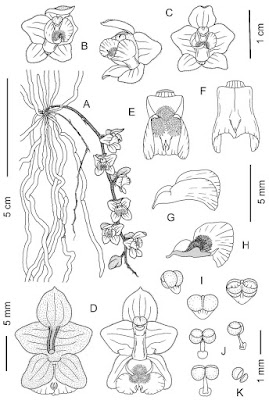[Most Recent Entries] [Calendar View]
Tuesday, November 6th, 2018
| Time | Event | ||||
| 2:06a | [Botany • 2018] Begonia yenyeniae (Begoniaceae) • A New Species from Endau Rompin National Park, Johor, Malaysia.
Abstract Begonia yenyeniae is a new species of horticultural value known only from the Endau Rompin National Park, Peninsular Malaysia. It is similar to Begonia rajah with which it had previously been confused in the number of tepals and leaf characters. The new species is compared with three similar species, B. foxworthyi, B. rajah and B. reginula and photographs of all four species and descriptions of B. yenyeniae and B. rajah are provided. Molecular analysis using the ndhF-rpl132 chloroplast marker confirms the four species as distinct. Amongst native species, the three variegated species, B. yenyeniae, B. rajah and B. reginula, are some of the most popular Malaysian begonias in cultivation. Based on its restricted distribution, Begonia yenyeniae, under the IUCN Red List Categories and Criteria, is assessed as Critically Endangered. Keywords: new species, Begonia yenyeniae, Begonia rajah, Begonia reginula, ornamental, conservation Begonia yenyeniae J.P.C.Tan, sp. nov. Section Jackia M.Hughes Diagnosis: Similar to Begonia rajah Ridl. (1894:213) in its handsome leaves, striking brownish-pink to brownish-red with greenish-yellow veins in young leaves becoming bronzy variegation at maturity; in its creeping growth habit, number of tepals in male (4 tepals) and female flowers (3), palmate leaf venation and many-flowered cymes, but several notable characters distinguish the new species, including its orbicular-reniform leaf blades (vs. subrotund with an abruptly acute apex in B. rajah), smaller stipules, 9–12 × 3–4 mm, three times longer than wide (vs. 15–20 × 10–12 mm, less than twice as long as wide), smaller ovate or obovate bracts 2–3 × 1.5–2 mm (vs. bracts bowl-shaped, wide ovate, 5–8 × 7.5–8 mm), margin shallowly crenate (vs. margin angular), bullate leaf surface (vs. conspicuously pronounced bullate). Furthermore, the leaf colour of cultivated B. rajah is more vivid and, in contrast, its tepals, stipules and bracts are also a deeper shade of pink, compared to those of B. yenyeniae. It is also similar to B. reginula Kiew (2005: 218) in its habit, leaf colour, less pronounced bullate blade, palmate venation, bracts, ovary with 3 equal wings of similar shape, but B. yenyeniae is different in its relatively smaller and narrower tepals 5–7 × 6 mm (vs. 6–10 × 9–11 mm in B. reginula), 3 in male or 4 tepals in female flowers (vs. 2 tepals in both male and female flowers) and rounded base (vs. subcordate), stipules with prominently keeled (vs. keel absent), and apex rounded (vs. apex attenuate). Although molecular data indicate a close relationship to B. foxworthyi ((1925: 311), the latter species is morphologically distinct in its conspicuously oblique leaf with an acute to acuminate apex (vs. orbicular-reniform with a rounded apex), its entire margin (vs. crenate) and plain green, non-bullate leaf surface (vs. purplish-green to brownish-purple and bullate) and its male flowers with 2 tepals (vs. 4 tepals). In addition, it usually grows on limestone substrates (vs. confined to granite substrates. Distribution: Endemic in Peninsular Malaysia, Johor, Mersing District, Endau-Rompin National Park, Sungai Selai. It is apparently a rare species as it is known only from the type locality in Endau Rompin National Park. Etymology: Named after Dr Sam Yen-Yen, Malaysian botanist, specialist in Zingiberaceae who first discovered the species and recognised its potential as an ornamental plant. Ecology: In primary lowland mixed dipterocarp forest, growing on moss-covered rocks, rarely epiphytic, near a waterfall in deep shade. Joanne Pei-Chih Tan, Sheh May Tam and Ruth Kiew. 2018. Begonia yenyeniae (Begoniaceae), A New Species from Endau Rompin National Park, Johor, Malaysia. PhytoKeys. 110: 23-37. DOI: 10.3897/phytokeys.110.25846 | ||||
| 2:10a | [Entomology • 2018] New Taxa and Records of Gryllacrididae (Orthoptera, Stenopelmatoidea) from South East Asia and New Guinea with A Key to the Genera
Abstract New records of Gryllacrididae from South East Asia to New Guinea are reported, new taxa are described and type specimens from European collections redescribed. The wing venation of the tegmina and its variation within the family is discussed. A new key to the 50 genera and subgenera of Gryllacrididae occurring in the area from South East Asia to New Guinea is provided. Six genera and two subgenera are introduced as new: Angustogryllacris gen. nov., Minigryllacris gen. nov., Monseremus gen. nov., Siamgryllacris gen. nov., Paraneanias gen. nov., Plexigryllacris gen. nov., Pseudasarca subgen. nov. of Asarcogryllacris Karny, 1937, Xiphilarnaca subgen. nov. of Metriogryllacris Karny, 1937. Two genera Gigantogryllacris Karny, 1937 and Pardogryllacris Karny, 1937 are reduced to subgeneric status under Gryllacris Audinet-Serville, 1831 and one monotypic genus Cyanogryllacris Karny, 1937 is synonymised with Capnogryllacris Karny, 1937. 70 species and nine subspecies are described as new: Eugryllacris gandaki sp. nov., Eugryllacris guomashan sp. nov., Eugryllacris crassicauda sp. nov., Eugryllacris crassicauda cambodiana ssp. nov., Eugryllacris serricauda sp. nov., Eugryllacris trabicauda sp. nov., Eugryllacris vermicauda sp. nov., Eugryllacris sulcata sp. nov., Eugryllacris inversa sp. nov., Gryllacris incornuta sp. nov., Gryllacris sok sp. nov., Gryllacris (Pardogryllacris) ovulicauda sp. nov., Gryllacris (Gigantogryllacris) bilineata sp. nov., Gryllacris (Gigantogryllacris) ligulata sp. nov., Lyperogryllacris forcipata sp. nov., Lyperogryllacris ocellata sp. nov., Lyperogryllacris khuntan sp. nov., Ocellarnaca disjuncta sp. nov., Ocellarnaca fusca sp. nov., Otidiogryllacris lawang sp. nov., Otidiogryllacris bamusbama sp. nov., Prosopogryllacris gamta sp. nov., Prosopogryllacris nigra sp. nov., Prosopogryllacris silacea sp. nov., Xanthogryllacris lineata sp. nov., Xanthogryllacris punctata sp. nov., Xanthogryllacris ralum sp. nov., Xanthogryllacris subrecta sp. nov., Aancistroger inarmatus sp. nov., Angustogryllacris bibulbata sp. nov., Aphanogryllacris sinustylata sp. nov., Aphanogryllacris nigritibiae sp. nov., Asarcogryllacris (Asarcogryllacris) brevis sp. nov., Asarcogryllacris (Asarcogryllacris) parapat sp. nov., Asarcogryllacris (Asarcogryllacris) robusta sp. nov., Asarcogryllacris (Pseudolarnaca) cornualis sp. nov., Asarcogryllacris (Pseudasarca) arborea sp. nov., Australogryllacris guttata sp. nov., Capnogryllacris (C.) erythrocephala fuscifrons ssp. nov., Capnogryllacris (C.) varifrons sp. nov., Capnogryllacris (C.) nigromaculata sp. nov., Capnogryllacris (C.) sakaerat toxica ssp. nov., Celebogryllacris brevitegmina sp. nov., Diaphanogryllacris annamita tenera ssp. nov., Diaphanogryllacris opulenta sp. nov., Diaphanogryllacris recta sp. nov., Diaphanogryllacris sinuata sp. nov., Eremus tigris sp. nov., Furcilarnaca chiangdao sp. nov., Furcilarnaca salit sp. nov., Furcilarnaca trilobata sp. nov., Haplogryllacris bilobulata sp. nov., Homogryllacris armigera sp. nov., Homogryllacris stabilis sp. nov., Larnaca (Larnaca) nigricornis sp. nov., Larnaca (Larnaca) tenuis sp. nov., Larnaca (Larnaca) samkos sp. nov., Larnaca (Larnaca) squamiptera sp. nov., Larnaca (Larnaca) subaptera sp. nov., Melaneremus sikkimensis sp. nov., Minigryllacris perpusilla sp. nov., Monseremus appendiculatus sp. nov., Neanias virens sp. nov., Neolarnaca vera nigrinotum ssp. nov., Phryganogryllacris extensa sp. nov., Phryganogryllacris gialaiensis fovealis ssp. nov., Phryganogryllacris nonangulata sp. nov., Siamgryllacris rufa sp. nov., Ultragryllacris pulchra nan ssp. nov., Ultragryllacris triangula sp. nov., Woznessenskia ampliata sp. nov., Woznessenskia bavi sp. nov., Zalarnaca (Glolarnaca) elegantula sp. nov., Zalarnaca (Glolarnaca) globiceps minor ssp. nov., Zalarnaca (Zalarnaca) maninjau sp. nov., Papuogryllacris diluta baiteta ssp. nov., Papuogryllacris rugifrons sp. nov., Papuogryllacris ligata bundi ssp. nov., Paraneanias striatus sp. nov., Plexigryllacris megastyla sp. nov. The following nomenclatural changes had to be done: Gryllacris bancana Karny, 1930a stat. nov. is raised to full species from subspecies of Gryllacris obscura Brunner von Wattenwyl, 1888; Xanthogryllacris inquinata (Karny, 1928c) comb. & stat. nov. is raised to full species from subspecies under Pardogryllacris dyak (Griffini, 1909); Eremus oberthuri Griffini, 1913a stat. nov. is raised to full species from subspecies under Eremus rugosifrons Brunner von Wattenwyl, 1888; Prosopogryllacris nigrovenosa (Karny, 1928b) stat. nov. is raised to full species from subspecies under Prosopogryllacris horvathi (Griffini, 1909); Xanthogryllacris punctipennis aurantiaca (Brunner von Wattenwyl, 1888) stat. reest. and Xanthogryllacris punctipennis dempwolffi (Griffini, 1909b) stat. reest. are treated as valid subspecies under Xanthogryllacris punctipennis (Walker, 1869) instead of being synonyms of the latter; Gryllacris thailandi Gorochov, 2007 and Gryllacris thailandi facemarmiger Gorochov et al., 2015 are downgraded to subspecies of Gryllacris vittata Walker, 1869. Gryllacris kledangensis Karny, 1923 and Gryllacris lombokiana Karny, 1926a become new synonyms of Gryllacris peracca Karny, 1923; Brachyntheisogryllacris abbreviata evolutior (Griffini, 1909a) becomes a new synonym of Brachyntheisogryllacris abbreviata (Brunner von Wattenwyl, 1888), and Haplogryllacris hieroglyphicoides (Chopard, 1924) a new synonym of Haplogryllacris simplex (Walker, 1871). The following new combinations are proposed: Capnogryllacris (C.) basaliatrata (Griffini, 1909c) comb. nov. from Cyanogryllacris Karny, 1937; Haplogryllacris aliena Walker, 1869 comb. nov. and Haplogryllacris durgensis (Gupta & Chandra, 2017) comb. nov. from Gryllacris Audinet-Serville, 1831; Homogryllacris artinii (Griffini, 1913b) comb. nov., Homogryllacris buyssoniana (Griffini, 1912c) comb. nov., Homogryllacris kurseonga (Griffini, 1913b) stat. & comb. nov. and Homogryllacris ? maindroni (Griffini, 1913a) comb. nov. from Brachyntheisogryllacris Karny, 1937; Larnaca (Larnaca) eugenii (Griffini, 1914b) comb. nov. from Metriogryllacris Karny, 1937; Larnaca (Larnaca) larnacoides (Karny, 1937) comb. nov. and Larnaca (Larnaca) jacobsoni (Griffini, 1913c) comb. nov. from Melaneremus Karny, 1937. Keywords: Orthoptera, Gryllacrididae, new species, new genera, revision, distribution records, tegmen venation, morphology, key to genera  Sigfrid Ingrisch. 2018. New Taxa and Records of Gryllacrididae (Orthoptera, Stenopelmatoidea) from South East Asia and New Guinea with A Key to the Genera. Zootaxa. 4510(1); 1-278. DOI: 10.11646/zootaxa.4510.1.1 | ||||
| 6:17a | [Ichthyology • 2018] Moenkhausia goya • A New Species (Characiformes: Characidae) from the upper rio Tocantins Basin, Central Brazil
Abstract A new species of Moenkhausia is described from the upper rio Tocantins basin, States of Goiás and Tocantins, Brazil. Moenkhausia goya, new species, can be distinguished from its congeners by the shape of the humeral blotch in combination with a uniform dark pigmentation covering the interradial membranes of the dorsal and anal fins. Among congeners, the new species is most similar to M. britskii Azevedo-Santos & Benine, M. grandisquamis (Müller & Troschel) and M. xinguensis Steindachner by presenting a deep body, a large, round humeral blotch and fins without discrete patches of dark pigmentation (i.e., without well-defined blotches or stripes). With the description of M. goya, the number of species endemic to the upper rio Tocantins basin (considered upstream from the mouth of the rio Paranã) is raised to 51. Of these, some are widespread in the upper rio Tocantins basin, while others seem to be restricted to one of its sub-basins. Keywords: Pisces, Cerrado, Moenkhausia xinguensis, State of Goiás, Taxonomy
Moenkhausia goya, new species Etymology. Moenkhausia goya is named after the Goyá, a South American ethnic group that lived in the central region of Brazil, which resisted to the encroachment of their territories until the 19th century. They also originated the name of the state of Goiás, where most of the distribution of the new species lies. Gabriel de Carvalho Deprá, Valter M. Azevedo-Santos, Oscar Barroso Júnior Vitorino, Fernando Cesar Paiva Dagosta, Manoela Maria Ferreira Marinho and Ricardo C. Benine. 2018. Moenkhausia goya (Characiformes: Characidae): A New Species from the upper rio Tocantins Basin, Central Brazil. Zootaxa. 4514(1); 87–96. DOI: 10.11646/zootaxa.4514.1.7 Resumo: Uma nova espécie de Moenkhausia é descrita da bacia do alto rio Tocantins, Estados de Goiás e Tocantins, Brasil. Moenkhausia goya, espécie nova, pode ser distinguida de suas congêneres pela forma da mancha umeral em combinação com uma pigmentação escura uniforme recobrindo as membranas inter-radiais das nadadeiras dorsal e anal. Entre as congêneres, a nova espécie é mais similar a M. britskii Azevedo-Santos & Benine, M. grandisquamis (Müller & Troschel) e M. xinguensis Steindachner por ter um corpo alto, uma mancha umeral grande e redonda e nadadeiras sem áreas de pigmentação escura discretas (i.e., sem manchas ou listras bem definidas). Com a descrição de M. goya, o número de espécies endêmicas à bacia do alto rio Tocantins (considerada à montante da barra do rio Paranã) sobe para 51. Destas, algumas estão amplamente distribuídas na bacia do alto rio Tocantins, enquanto outras parecem estar restritas a uma de suas subbacias. Palavras-chave: Cerrado, Estado de Goiás, Moenkhausia xinguensis, Taxonomia | ||||
| 9:23a | [Botany • 2018] Chiloschista pulchella (Orchidaceae: Aeridinae) • A New Orchid Species from Lao PDR
Abstract The new species, Chiloschista pulchella (Orchidaceae: Aeridinae) was discovered in Hin Nam No Nature Protected Area, Khammoune Province of the central Laos. The paper provides detailed description and illustration of this species, which is identified as a local endemic of karstic rocky limestone of the northern part of the protected area. It differs from all known congeners in the thin lip, median lip lobe dissected into two small subulate lobules, as well as in large purple blotches on the lip side-lobes never found in other species of this genus. The newly discovered plant represents interest for cultivation as an ornamental plant and needs protection in its natural habitats. Keyword: Laos, Orchids, Plant diversity, Plant taxonomy, Limestone endemism, Hin Nam No Nature Protected Area Chiloschista pulchella Aver. & K.S. Nguyen, sp. nov. Described from central Laos (“Laos, Khammoune Province, Boualapha District, ..., within the territory of Hin Nam No Nature Protected Area, primary dry evergreen and semi deciduous broad-leaved forest on very steep rocky slope near karstic hill top composed with solid, marble-like highly eroded limestone at 350–430 m a.s.l., epiphyte on tall tree, rare) Type (“9 May 2018, L. Averyanov, K. S. Nguyen, T. Maisak, L. Xaiyavongsa, S. Keovankham, AL 889” – LE (holotype). Distribution: Central Laos: Khammoune province (Boualapha district, the territory of Hin Nam No Nature Protected Area). Endemic. Habitat, ecology and conservation status: Miniature aphyllous epiphytes growing in primary dry evergreen and semideciduous, broad-leaved forests on karstic rocky limestone, at an elevation of 350–430 m. Rare. Currently, the IUCN Red List status should be ascertained as Data Deficient (DD). Etymology: The specific epithet refers to the attractive, colorful flowers having purple lip side lobes. Notes. Chiloschista pulchella strikingly differs from all its congeners by the flat lip apex (not fleshy), the median lip lobe dissected into two small subulate lobules, and by the presence of large purple blotches on the sidelobes of the lip which is never found in any other species of the genus. This new species belongs to the group of species with a simple operculum (not having any appendages), but has no certain similarity with any other species of this group. Formally, it can be compared with C. exuperei (Guillaumin) Garay, which also has a bilobulate median lip lobe. However, both these species are obviously different in their floral morphology Leonid V. Averyanov, Khang Sinh Nguyeh and Tatiana V. Maisak. 2018. Chiloschista pulchella (Orchidaceae: Aeridinae) New Orchid Species from Lao PDR. Taiwania. 63(4); 389-392. DOI: 10.6165/tai.2018.63.389 |
| << Previous Day |
2018/11/06 [Calendar] |
Next Day >> |
















